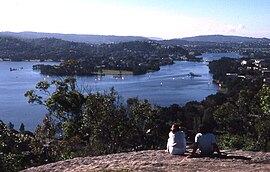|
Collaroy Plateau
Collaroy Plateau is a suburb of northern Sydney, in the state of New South Wales, Australia. Collaroy Plateau is 22 kilometres north-east of the Sydney central business district, in the local government area of Northern Beaches Council and is part of the Northern Beaches region. Collaroy Plateau was designated as a separate suburb in 1977 with a postcode of 2098, but was reassigned as a locality within Collaroy in 1984, with the postcode changing to 2097 as part of Collaroy. In 2001 all localities were renamed Urban Places. In 2011 Collaroy Plateau, along with Wheeler Heights, was re-established as a suburb by the Geographical Names Board of NSW, after lobbying by the community, who had never ceased considering it to be a suburb since its loss of that title in 1984.[4] Collaroy Plateau has views of Sydney's Northern Beaches, with parts of the suburb overlooking Collaroy Beach, Long Reef Beach, Narrabeen Beach and Narrabeen Lagoon. Collaroy Beach is also the landing point of the PPC-1 submarine cable, one of three backhaul communication links connecting Australia to the wider Internet.[5] History The name Collaroy is aboriginal for "big reeds",[6] and the suburb began its life as part of Narrabeen. In 1881, the steamer "Collaroy" ran aground on Long Reef at the southern point of the suburb. Crowds came from all around the district to see the wreck that subsequently gave its name to the suburb. Its anchor can still be found at the Narrabeen Primary School.[7] Collaroy Plateau Post Office opened on 1 April 1949 and closed in 1988. Collaroy Plateau West Post Office opened on 1 November 1967 and was renamed Collaroy Plateau in 1996.[8]
Landmarks Collaroy ReservoirCollaroy Reservoir (Elevated) (WS 30) was one of a small group of reservoirs in the Sydney Water system,[11] which was originally constructed for railway purposes. It demonstrated a significant adaptation of railway technology for water supply purposes. The listing included the reservoir and all associated pipework, valves and valve houses to the property boundary.[12] The reservoir was demolished in 2018 by Sydney Water.[13] Collaroy Trig StationThe requirement for accurate maps in Australia led to the development of a control network of Trig stations. The word "trig" is short for trigonometric. Trig stations can be located on landmarks such as hills or high man-made structures such as buildings, or grain silos or water reservoirs. The process of triangulation was used as the method to provide the locations of the trig stations, which were then used to connect to smaller scale surveys or for mapping.[14] Collaroy radar station 54RS - WWIIIn February 1942 American forces arrived in Australia bringing with them MAWDs (Modified Air Warning
Device); which filled an urgent need in Australia. The operators sat out in the open exposed to the elements and hand turned the aerial, even during tropical downpours, heavy winds, etcetera. Northern Beaches Various parts of Collaroy Plateau overlook Collaroy Beach, Long Reef Beach, Narrabeen Beach and Narrabeen Lagoon. The view as described in 1921
Notable peopleJoseph Lade PawseyJoseph Lade Pawsey Joseph Lade Pawsey MSc PhD (1908–1962) conducted Australia's first successful experiment to detect radio waves from the sun on 3 October 1945 at the Radar Station at Plateau Park, Collaroy Plateau. He then became the leader of CSIRO's Radiophysics Radio Astronomy Division from 1945 until his death in 1962. The work of Joseph Pawsey has led to the development and commercialization of modern technologies including wi-fi. Frank HurleyJames Francis (Frank) Hurley (1885–1962), adventurer, photographer and film maker, was born on 15 October 1885 at Glebe, Sydney. He died at his home at Collaroy Plateau on 16 January 1962.[18]
Follow the link for some of his photography taken on Collaroy Plateau and other locations. Ted Dellit, a WW2 radar veteranTed[19] lived on Collaroy Plateau from 1961 for many years. Open public spaces
Native flora  Warringah is home to over 900 native plant species, subspecies, varieties and forms that can be found from the coastal sand dunes and estuaries to sandstone ridge tops and plateaux. Collaroy Plateau has dry sclerophyll forests (Shrubby subformation) 'Shrubby dry sclerophyll forest has typically Australian species such as waratahs, banksias, wattles, pea-flowers and tea-trees. There is a sparse ground cover of sedges and grasses growing on sandy soils that are among the world's least fertile.' Infrastructure and developmentTransportThe main form of transport after private cars is by public transport - buses. Schools and churchesSchools
Churches SportCollaroy Plateau Cricket ClubEstablished in 1955, the club represents the local community in the Manly Warringah Cricket Association and the Manly Warringah Junior Cricket Association. It stands as one of the largest park cricket clubs on the Northern Beaches with around 25 junior and seniors teams. Numerous juniors have gone on to play for higher honors in Sydney Grade cricket. The club emblem is the Collaroy Plateau Water Tower ("Collaroy Reservoir") and their home ground is Vic Huxley Oval (Collaroy Plateau Park). [24] ReferencesNotes
Bibliography
External linksWikimedia Commons has media related to Collaroy Plateau, New South Wales. |
||||||||||||||||||||||||||||||||||||

